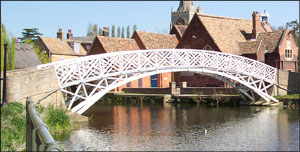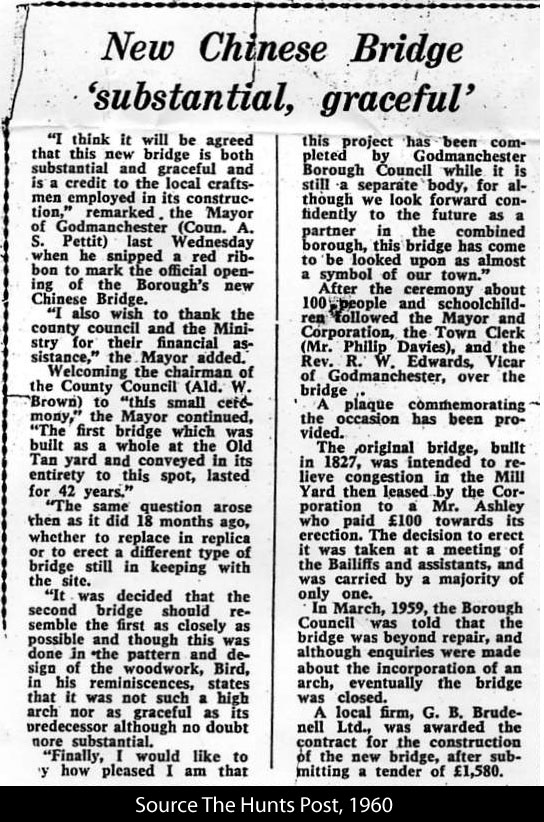
The Chinese Bridge is a landmark of our town and has stood since 1827. The bridge is now in its forth generation. Originally designed and constructed by an Irish Architect  by the name of James Gallier, rebuilt in the 1860s and again rebuilt in 1960 with a replica by G.B. Brudenall Ltd of Godmanchester for the sum of £1,580, on behalf of the council (Select the image on the right for the newspaper article) and again replaced with a replica 50 years later by CTS Bridges, Shepley, Huddersfield.
by the name of James Gallier, rebuilt in the 1860s and again rebuilt in 1960 with a replica by G.B. Brudenall Ltd of Godmanchester for the sum of £1,580, on behalf of the council (Select the image on the right for the newspaper article) and again replaced with a replica 50 years later by CTS Bridges, Shepley, Huddersfield.
The design of the bridge was influenced by the popular 18th Century style on Chinoiserie, a French term, indicating “Chinese-esque” which was a recurring theme throughout Europe and is a mixture of Eastern and Western styles for both decoration and shape.
The original Architect Gallier, did not come to Godmanchester for the sole purpose of designing and erecting the Chinese Bridge. He was originally commissioned to be “Clark of the Works" and oversee the construction of Huntingdon’s Prison, which can still be found at St-Peters road today. From Galliers’ autobiography he describes his time in Huntingdon and Godmanchester with joy and great sadness. The following is a quote from his autobiography:
|
“In 1826 I was flavoured a letter from Mr. Wilkins saying that, if I still had a desire to be engaged as a clerk of the works, he had something which might suit me; and if I could meet him in the town of Huntingdon, he could there point out the duties I should have to perform if I entered into the engagement. I attended at the appointed time and place, and found he was about to build a prison for the county of Huntingdon.
Having examined into my fitness for the situation, he engaged me at a salary of four pounds a week, to take charge of the plans, and to see that the work was performed by the contractor in accordance with the drawings and specification.
I was delighted with my new situation, being the first appointment I ever had that held out a prospect of advancing my position in life; so, having returned to London and put my affairs in order, I took my family down to Huntingdon and soon had everything put into proper working condition.
In a year after my marriage our first child was born, which was a boy, but he died early in infancy; our second was a girl, who lived to the age of four years our third was my dear James, the only one left now; he was born in Huntingdon on the 25th September, 1827, and was Christened in the picturesque old church of that town; our forth was a girl, born after our return to London, but died in early childhood.
My next neighbour at Huntingdon was Mr. Robert Carruthers, a literary man, who carried on the business of a book binder at the same time with the management of the county school. He published a history of Huntingdon and other works; and, having afterwards removed to Scotland, became editor and ultimately the proprietor of the “Inverness Courier” which he conducted with great ability for many years. This excellent man was of much service to me, he directed me to a course on reading and put me in the way of obtaining books. I became a member of a debating society and a social book club; I also joined a Masonic lodge, and, during my two years of my stay at Huntingdon, my knowledge of life and the ways of Society became much enlarged.
I made a small wooden model of the gaol, so constructed that the roofs and upper storeys could be separately lifted up to show the interior divisions of all the yards , passages, rooms, and cells throughout the building this I sent to Mr. Wilkins, who was highly pleased with it.
I was frequently called on by persons of the town and neighbourhood of Huntingdon to give plans for alterations to their houses; I also planned and superintended the erection of a small wooden bridge, of original deign, across a branch of the River Ouse at Godmanchester, and I now began to fancy myself a person of some little importance. To understand the degree of elation I at that time felt, a man must have started in life as I had done, on nearly the lowest rung of the social ladder, and have toiled his way painfully upward, even to the humble position I had then attained." |
After completing his work in Huntingdon James Gallier returned to London and started work on the redevelopment of the Grosvenor Estate in Mayfair. Unfortunately Gallier became bankrupt and emigrated to America in 1832 with his family. Gallier had a successful career in America, his noteable achievements, which are now National Historic Landmarks include Gallier Hall, Pontalba Buildings, Government Street Presbyterian Church, the Leeds Davies Building, The Second Christ Church Catherdral, Barton Academy and Belle Helene.
James Gallier died on October 1866 during a trip on the steamer Evening Star, from New York to New Orleans which sank during a Hurricain. His second wife, Catherine Robinson died with him.
To record the replacement of the Chinese Bridge in 2010, the Porch Museum decided to record the removal and replacement of the bridge. These few days filming have now been put together into a historical DVD. The film also contains interviews and new details on James Gallier from Godmanchesters best liked historian Ken Sneath. We further investigate Godmanchesters second bridge linking Island Hall with its Island, the story is told by Christopher Vane Percy.
To purchase this DVD please visit the Godmanchester Porch Museum Shop for further information.
The following links are extracts from the DVD showing interviews with David Brown and Christopher Vane Percy.
Click the image below for a short gallery of Chinese Bridge Photos
